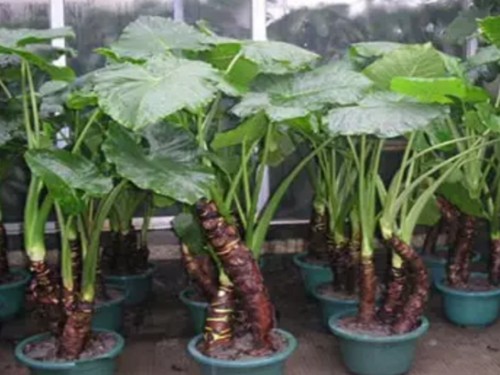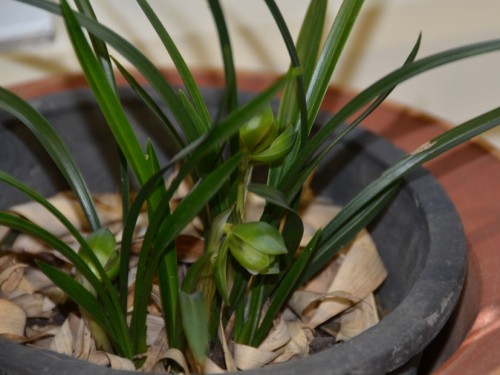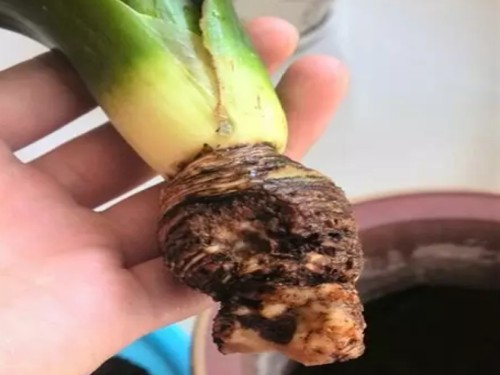What about the rotten roots of Guanyin in potted plants?
Dishui Guanyin is a trade name, also known as "Dishui lotus" and bergamot lotus. Other common names include trace taro, wolf venom (Guangdong), wild taro, mountain taro, big root taro, big worm taro, celestial taro, Tianmeng, and so on. Taiwan's calla lotus refers to sea taro, so what about the rotten roots of dripping water Guanyin?
Dripping Guanyin is prone to rot in summer, mainly caused by the wet soil. Pull up the dripping Guanyin, cut off the rotten roots, and wear rubber gloves when cutting the roots (Dishui Guanyin is poisonous! Be careful if you have skin allergies. Cut off a little of the healthy tissue near the rotten part. After cutting off the rotten root, dry the root, plant it in plain sand or sand soil after the wound heals, do not water it for the time being, wait until the basin soil is dry and then water it. It will be the same in the future, no work, no watering. In addition, it should be placed in a ventilated place.

1. The cause of the rotten root of Dishui Guanyin
Dishui Guanyin is divided into soil culture and water culture. The soil dripping Guanyin rotten root is mainly caused by dripping Guanyin basin soil is too wet. If the basin soil is too wet, it is easy to rot the roots of dripping Guanyin. The reason why the basin soil is too wet may be that you water too much, resulting in stagnant water in the basin, or it may be that the soil is sticky, poor air permeability, and it is easy to accumulate water.
The primary cause of dripping Guanyin rotting root is too much watering. Dripping Guanyin likes water, but be careful not to accumulate water in the basin. Not only the dripping Guanyin, but also many flowers are like this. When the potted soil is dry, it should not be watered thoroughly at once, not too frequently.
The second cause of rotting roots is diseases and insect pests. If this situation is not too serious, sprinkle some essential oil around the flowerpot, disinfect and change the soil. The phenomenon of root rot often occurs in dripping Guanyin mainly because the tissue of dripping Guanyin stem is relatively loose. if the water quality is very poor, it may cause rotting root and stem rot.
2. The solution of dripping Guanyin rotting root
The solution to the rotten roots of dripping Guanyin is as follows: pull up the dripping Guanyin, cut off the rotten roots, and cut off a little of the healthy tissue near the rotten part to make sure that what is left is white. After cutting the root, pay attention to dry it, wait for the wound to heal, and then plant it in a well-drained, fertile, acidic soil. You can also apply some plant ash to the wound for disinfection and sterilization.
It should be noted that the juice of dripping Guanyin is poisonous and you should wear rubber gloves when cutting the roots to prevent yourself from poisoning. After dripping Guanyin is planted in the soil, remember to dry thoroughly and then water it, so that it will not be dry or watered. In addition, put it in a ventilated place for breeding.
Hydroponic dripping Guanyin rotten root should remove its root rot, wash the mucus from the tuber and root system, and change water or nutrient solution. Pay attention to keep the bottle water clean when breeding.
At the beginning of raising dripping Guanyin, it often caused rotten roots due to diseases and insect pests or too much watering, resulting in the gradual withering of originally luxuriant plants, so what should we do if dripping Guanyin rotten roots?
Method of operation:
1. Insert the small wooden cabinet into the soil next to the dripping Guanyin root system, peel off the soil bit by bit from the root, and take out the rotten root completely.
2. Cut off the rotten root.
3. Cut all the branches and leaves.
4. Rinse in clean water, then soak in carbendazim or potassium permanganate solution for 5 minutes, then rinse with clean water and leave it in a ventilated place for one day and night.
5. disinfect flowerpots and disinfect new soil. In order to ensure the good permeability of new soil, it is best to choose the soil with more sandy soil.
6. If the new soil is too dry, you should pour less water on rice panning. In the future, you would rather lack some water than water more, and insist on not watering it. Don't bury the roots too deep.
7. If the rotten root is not too serious, it can not be dealt with according to the above steps. If the rotten root is above the basin soil, you can dig out the rotten part, smear the wound with agricultural streptomycin, and irrigate the root with diluted carbendazim solution.
The soil-fed Guanyin rotten root is mainly caused by the dripping Guanyin basin. The dripping Guanyin rotting root has a lot to do with the water quality. for the solution, the soil-raised dripping Guanyin pulls up the dripping Guanyin, cuts off the rotten root, and drips it to dry. After the wound heals, it will be planted in the well-drained, fertile and acidic soil, while the water-fed Guanyin rotten root should be removed. Wash the mucus from tubers and roots and change water or nutrient solution.
Time: 2019-06-01 Click:
- Prev

How to remedy the rotten roots of orchids? How to deal with it?
Some flower lovers who are beginners to raise orchids often do not know much about the habits of orchids and find it difficult to raise orchids well, burn their tips and pour seedlings, and there are only a few dead piles left after a year or two. Most of the reasons are caused by the rot of Langen. As the saying goes, orchids grow roots first, with good roots, exuberant leaves and fragrant flowers. To cultivate a good orchid
- Next

Management after the rotting Root of Magnolia
The rotten roots of Cymbidium are mainly caused by excessive watering, high temperature, over-concentrated fertilization or raw fertilizer, and some may be caused by infection caused by bacteria in the cultivation medium. Whether the orchid can survive after its rotten roots mainly depends on whether the root axis is better, whether there is any separation between the leaf and the root axis, as well as the injury of the new leaves in the middle.
Related
- Fuxing push coffee new agricultural production and marketing class: lack of small-scale processing plants
- Jujube rice field leisure farm deep ploughing Yilan for five years to create a space for organic food and play
- Nongyu Farm-A trial of organic papaya for brave women with advanced technology
- Four points for attention in the prevention and control of diseases and insect pests of edible fungi
- How to add nutrient solution to Edible Fungi
- Is there any good way to control edible fungus mites?
- Open Inoculation Technology of Edible Fungi
- Is there any clever way to use fertilizer for edible fungus in winter?
- What agents are used to kill the pathogens of edible fungi in the mushroom shed?
- Rapid drying of Edible Fungi

